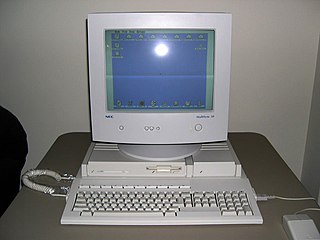Related Research Articles

The Acorn Electron was a lower-cost alternative to the BBC Micro educational/home computer, also developed by Acorn Computers Ltd, to provide many of the features of that more expensive machine at a price more competitive with that of the ZX Spectrum. It had 32 kilobytes of RAM, and its ROM included BBC BASIC II together with the operating system. Announced in 1982 for a possible release the same year, it was eventually introduced on 25 August 1983 priced at £199.

The Amiga 500, also known as the A500, is the first low-end version of the Amiga home computer. It contains the same Motorola 68000 as the Amiga 1000, as well as the same graphics and sound coprocessors, but is in a smaller case similar to that of the Commodore 128.

A motherboard is the main printed circuit board (PCB) in general-purpose computers and other expandable systems. It holds and allows communication between many of the crucial electronic components of a system, such as the central processing unit (CPU) and memory, and provides connectors for other peripherals. Unlike a backplane, a motherboard usually contains significant sub-systems, such as the central processor, the chipset's input/output and memory controllers, interface connectors, and other components integrated for general use.

Celeron is Intel's brand name for low-end IA-32 and x86-64 computer microprocessor models targeted at low-cost personal computers.
Chip RAM is a commonly used term for the integrated RAM used in Commodore's line of Amiga computers. Chip RAM is shared between the central processing unit (CPU) and the Amiga's dedicated chipset. It was also, rather misleadingly, known as "graphics RAM".

The Pentium II brand refers to Intel's sixth-generation microarchitecture ("P6") and x86-compatible microprocessors introduced on May 7, 1997. Containing 7.5 million transistors, the Pentium II featured an improved version of the first P6-generation core of the Pentium Pro, which contained 5.5 million transistors. However, its L2 cache subsystem was a downgrade when compared to the Pentium Pros; and it is a single-core microprocessor.

The Pentium III brand refers to Intel's 32-bit x86 desktop and mobile CPUs based on the sixth-generation P6 microarchitecture introduced on February 28, 1999. The brand's initial processors were very similar to the earlier Pentium II-branded processors. The most notable differences were the addition of the Streaming SIMD Extensions (SSE) instruction set, and the introduction of a controversial serial number embedded in the chip during manufacturing. The Pentium III is also a single-core processor.

The Pentium Pro is a sixth-generation x86 microprocessor developed and manufactured by Intel and introduced on November 1, 1995. It introduced the P6 microarchitecture and was originally intended to replace the original Pentium in a full range of applications. While the Pentium and Pentium MMX had 3.1 and 4.5 million transistors, respectively, the Pentium Pro contained 5.5 million transistors. Later, it was reduced to a more narrow role as a server and high-end desktop processor and was used in supercomputers like ASCI Red, the first computer to reach the trillion floating point operations per second (teraFLOPS) performance mark. The Pentium Pro was capable of both dual- and quad-processor configurations. It only came in one form factor, the relatively large rectangular Socket 8. The Pentium Pro was succeeded by the Pentium II Xeon in 1998.

The Am5x86 processor is an x86-compatible CPU announced in November of 1995 by AMD for use in 486-class computer systems. It began shipping in December of 1995, with a base price of $93 per unit in bulk quantities. Before being released, it was in development under the codename "X5".

In computing, overclocking is the practice of increasing the clock rate of a computer to exceed that certified by the manufacturer. Commonly, operating voltage is also increased to maintain a component's operational stability at accelerated speeds. Semiconductor devices operated at higher frequencies and voltages increase power consumption and heat. An overclocked device may be unreliable or fail completely if the additional heat load is not removed or power delivery components cannot meet increased power demands. Many device warranties state that overclocking or over-specification voids any warranty, however there are an increasing number of manufacturers that will allow overclocking as long as performed (relatively) safely.

The Athlon 64 is a ninth-generation, AMD64-architecture microprocessor produced by Advanced Micro Devices (AMD), released on September 23, 2003. It is the third processor to bear the name Athlon, and the immediate successor to the Athlon XP. The second processor to implement the AMD64 architecture and the first 64-bit processor targeted at the average consumer, it was AMD's primary consumer CPU, and primarily competed with Intel's Pentium 4, especially the Prescott and Cedar Mill core revisions. It is AMD's first K8, eighth-generation processor core for desktop and mobile computers. Despite being natively 64-bit, the AMD64 architecture is backward-compatible with 32-bit x86 instructions. Athlon 64s have been produced for Socket 754, Socket 939, Socket 940, and Socket AM2. The line was succeeded by the dual-core Athlon 64 X2 and Athlon X2 lines.
In-circuit emulation (ICE) is the use of a hardware device or in-circuit emulator used to debug the software of an embedded system. It operates by using a processor with the additional ability to support debugging operations, as well as to carry out the main function of the system. Particularly for older systems, with limited processors, this usually involved replacing the processor temporarily with a hardware emulator: a more powerful although more expensive version. It was historically in the form of bond-out processor which has many internal signals brought out for the purpose of debugging. These signals provide information about the state of the processor.

In computing, a northbridge is one of two chips comprising the core logic chipset architecture on a PC motherboard. A northbridge is connected directly to a CPU via the front-side bus (FSB) to handle high-performance tasks, and is usually used in conjunction with a slower southbridge to manage communication between the CPU and other parts of the motherboard. Since the 2010s, die shrink and improved transistor density have allowed for increasing chipset integration, and the functions performed by northbridges are now often incorporated into other components. As of 2019, Intel and AMD had both released chipsets in which all northbridge functions had been integrated into the CPU. Modern Intel Core processors have the northbridge integrated on the CPU die, where it is known as the uncore or system agent.

In computer hardware, a CPU socket or CPU slot contains one or more mechanical components providing mechanical and electrical connections between a microprocessor and a printed circuit board (PCB). This allows for placing and replacing the central processing unit (CPU) without soldering.

The Atari TT030 is a member of the Atari ST family, released in 1990. It was originally intended to be a high-end Unix workstation, but Atari took two years to release a port of Unix SVR4 for the TT, which prevented the TT from ever being seriously considered in its intended market.
AMD Cool'n'Quiet is a CPU dynamic frequency scaling and power saving technology introduced by AMD with its Athlon XP processor line. It works by reducing the processor's clock rate and voltage when the processor is idle. The aim of this technology is to reduce overall power consumption and lower heat generation, allowing for slower cooling fan operation. The objectives of cooler and quieter result in the name Cool'n'Quiet. The technology is similar to Intel's SpeedStep and AMD's own PowerNow!, which were developed with the aim of increasing laptop battery life by reducing power consumption.
The memory controller is a digital circuit that manages the flow of data going to and from the computer's main memory. A memory controller can be a separate chip or integrated into another chip, such as being placed on the same die or as an integral part of a microprocessor; in the latter case, it is usually called an integrated memory controller (IMC). A memory controller is sometimes also called a memory chip controller (MCC) or a memory controller unit (MCU).
Kickstart is the bootstrap firmware of the Amiga computers developed by Commodore International. Its purpose is to initialize the Amiga hardware and core components of AmigaOS and then attempt to boot from a bootable volume, such as a floppy disk. Most Amiga models were shipped with the Kickstart firmware stored on ROM chips.

Phenom II is a family of AMD's multi-core 45 nm processors using the AMD K10 microarchitecture, succeeding the original Phenom. Advanced Micro Devices released the Socket AM2+ version of Phenom II in December 2008, while Socket AM3 versions with DDR3 support, along with an initial batch of triple- and quad-core processors were released on February 9, 2009. Dual-processor systems require Socket F+ for the Quad FX platform. The next-generation Phenom II X6 was released on April 27, 2010.
Coherent Accelerator Processor Interface (CAPI), is a high-speed processor expansion bus standard for use in large data center computers, initially designed to be layered on top of PCI Express, for directly connecting central processing units (CPUs) to external accelerators like graphics processing units (GPUs), ASICs, FPGAs or fast storage. It offers low latency, high speed, direct memory access connectivity between devices of different instruction set architectures.
References
- Meyers, M.; Jernigan, S. (2004). Mike Meyers' A+ Guide to PC Hardware. Mike Meyers' A+ Guide Series. McGraw-Hill Technology Education. ISBN 978-0-07-223119-9 . Retrieved 2022-07-11.